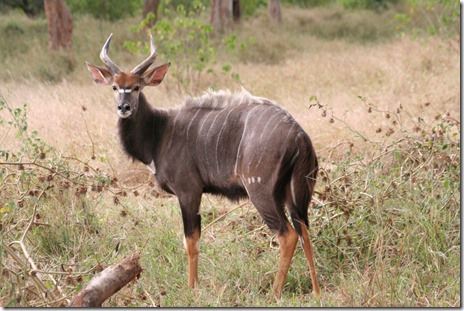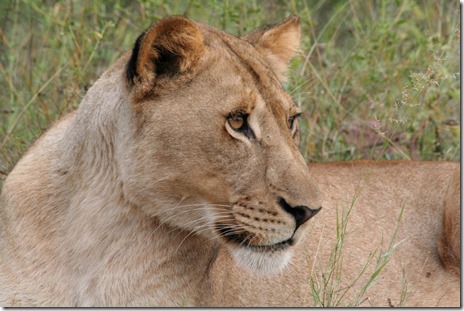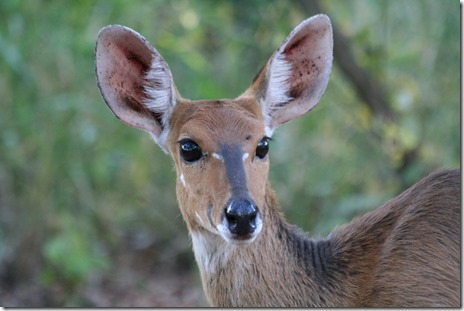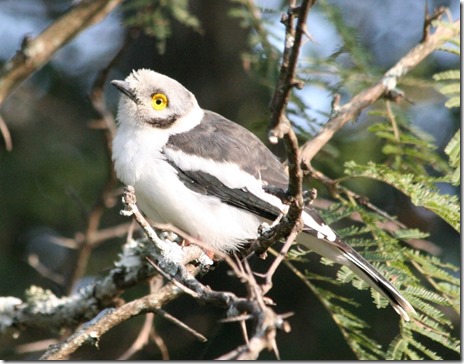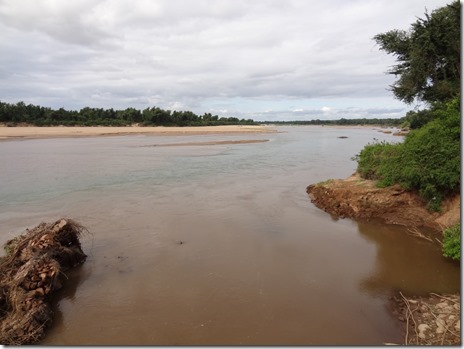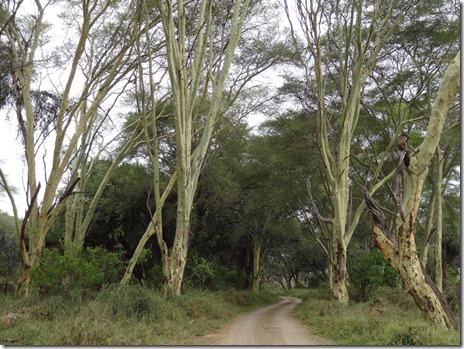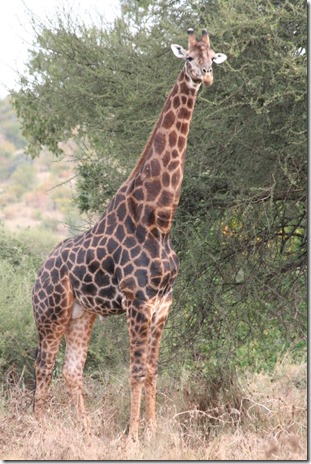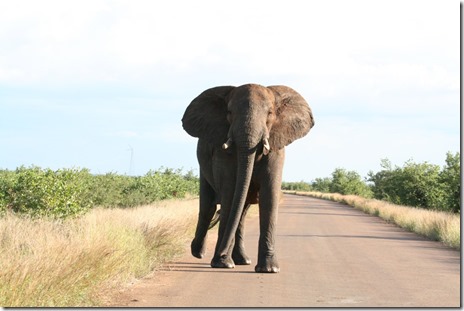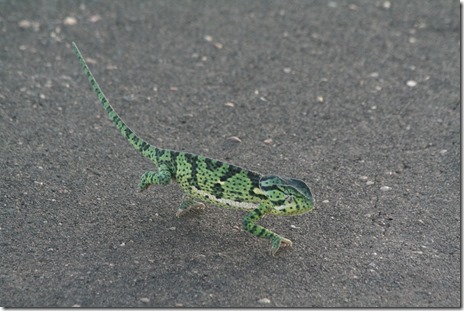Kruger National Park lies in the far north-east of the country, bordering Zimbabwe to the north and Mozambique to the east. It is huge, the drive from north to south being over 400km. The park is named after one of South Africa’s former presidents, Paul Kruger, and it would be easy to assume he was fundamental in establishing this huge conservation area. Not the case. Its existence owes itself to the first warden, James Stevenson-Hamilton, who wanted to establish an area to protect the country’s fast-disappearing wildlife. Apparently he suggested the name in the hope that it would help reduce Afrikaner opposition to declaration of the park. Our guide book tells us that the only interest Paul Kruger had in wild animals was how good their biltong tasted!
We were starting at the top of the park and working our way south. The entrance sign at the Punda Maria park gate wasn’t quite what we’d expected of South Africa’s flagship national park …
Our first night was in Punda Maria camp, about 40km south of the northern boundary. We got an early night and, despite the moonlight from the nearly full moon, we slept pretty well. That was until the early hours when Angela woke to the pitter-patter of something running over the roof of the tent. It loudly patted back and forth a few times, then jumped onto the roof rack behind the tent and seemingly off the car. She then heard the light rattle of something climbing the roof tent ladder. She could vaguely see out of the front as we just had the mosquito net zipped down rather than the canvas cover. Peering into the moonlit gloom she watched as a pair of large rounded ears appeared at the top of the ladder, followed slowly by the silhouette of a round head, a rotund body and a very bushy tail. It was a Thick-tailed Bushbaby. From the front of the tent it walked with great ease along the very narrow ledge to the side, right past Angela watching through the side window, and then up onto the roof again. By now Gareth was awake and we both listened as it trotted across the roof again, appeared at the front corner and climbed down the thin pole holding the flysheet up, before clambering off the car and scampering away across the dry earth of the camp site. It was magic.
We tried to get back to sleep but then a lion started roaring and kept on for several hours. Most other campers were on the road early in search of the lions but we were tired so had a lie in and headed out mid-morning. Our first sighting was a group of Vultures sitting in several trees. They must have been a kill but we couldn’t see it.
D’you come here often?
We saw lots antelope including more Nyala, the pretty antelope we’d first seen in Marakele. They were everywhere here.
Male Nyala. Wonder if that’s where Adam Ant got the idea for his face stripe?
Then we came across several cars in the road – a sure sign that something interesting has been spotted. There was a pair of lions in the middle of the road. She promptly lay down in the middle of the road to have a snooze, with 2 cars on one side and three of us on the other, including a large camper van. The van then moved and blocked our view, so we edged forward a bit to restore it. We’d left room so as not to crowd the lions, but another car then turned up and pulled right in front of us completely blocking our view again. It was not the first time other people had done this – they just want to get the best view they can and don’t care about anyone else or the animals. We managed to move the car again, which having turned the engine off meant making more noise which fortunately didn’t disturb the lions.
We think he has something of Kurt Russell or Michael Douglas about him…
Stunning lioness
As you can see, we had an amazing view. That was until the camper van that had originally blocked our view decided he’d seen enough and drove through the middle of everything and right past the lions scaring them both away into the bush. Selfish git.
The male was actually injured. He had a cut right round his waist which looked like he’d been in a snare. There is a huge problem with poaching in Africa and not just rhino and elephant. All sorts of animals are poached, for horn, ivory, body parts, skins, bones, and meat. You name it, someone wants it (it has to be said, mostly in the East and Middle East – places like China, Vietnam, Taiwan and Yemen). Sadly it seems that National Park staff members have been involved as they can make a year’s salary from one or two animals. When we got back to camp we reported him to the rangers but they were already aware of him. Our neighbours, Jake and Maxie, told us that they’d seen the same lions later and that he had been treated by the vet. Apparently the vet had been trying to track him down for the last day. He was looking strong when we saw him and the pair were obviously ‘courting’ so if he had enough energy for that we think he has a pretty good chance of recovering. ![]()
Nasty cut around his waist
Back in camp we discovered we had new friends. A Bushbuck and her fairly well-grown fawn were residents of the camp and seemed to like our little corner. She in particular got really close to us without being scared. They’re a bit bigger than a Muntjac deer (and quite a lot prettier…).
Bushbuck doe
There is a waterhole on the edge of camp (outside the 2 metre electric fence that keeps us safe from the wild things we’ve come to see) which attracted elephants and buffalo at night and various birds during the day, including Marabou Storks, one of the ugliest but most interesting birds you’re likely to see…
This one was sitting down. The dangly thing is his crop. Very weird but great if you want seconds or thirds…
We also got bird parties flying through camp, with lots of different species of small birds mixed up together. They included a group of Helmet-shrikes, very active little birds that don’t sit still for long so are really hard to photograph, but Gareth managed to snap this one. They have yellow eyes as well as a yellow wattle around the eye. Smart.
White-crested Helmet-shrike
The next day we chilled and just headed out in the afternoon. We drew up behind another car which had stopped at the side of the road. We slowly pulled up level with them. “What have you seen?” we asked. “Nothing, we’re just pouring a gin and tonic. Would you like one? We have a spare glass.” What a marvellous idea. It was incredibly tempting but we declined. Introductions were made; Mike, Hester, Frank and Joy – the boys were brothers. We had a chat and promised to catch up before we left.
The next day we had an early start and headed right up to the far north of the camp and to the most north-easterly point of South Africa. Crooks Corner is on the border between SA, Zimbabwe and Mozambique and was something of a no-man’s-land in the past, making it a hot spot for rogues, illicit traders and other criminals, hence the name. It is on the great Limpopo River, a name which conjures up images of 1950s Hollywood films of jungle explorers and ‘great white hunters’ but which was pretty uninspiring when we were there.
A rather murky Limpopo River
Current resident of Crook’s Corner
Our trip took us through some beautiful countryside including an unusual Fevertree forest, where the tree bark was a beautiful soft and almost luminous yellow-green. Unfortunately you can’t really tell from the photo but here it is anyway.
Fevertree forest
We had lunch in the beautiful Pafuri picnic site, set on the banks of the Luvuvhu River under huge shady Jackalberry trees. It also had toilets, a kitchen, braai facilities and even hot water on tap for a nice cuppa. We had invested in a pair of thermos-type cups that the campers we’d met in Marakele had told us about. They were dirt cheap and we could make a cup of tea to sip on our journey, which we were really enjoying, especially on those days when we were up early looking for game and could have our morning cuppa on the hoof. At Pafuri we could top our cups up for the trip back to camp. The picnic site had its own residents, with monkeys and baboons taking their opportunities and pinching food from careless and inattentive tourists, just as they do in the camps. They are a pest but they are incredibly intelligent and resourceful and wonderful to watch.
Chacma Baboon and sproglet
Our journey back to camp took us past several Giraffe, including this handsome boy whose coat was one of the darkest we had seen, almost black in places.
Then we passed a large bull elephant that was striding purposefully towards the road. We stopped and turned the engine off to watch him cross. He climbed up the bank onto the road and started to walk towards us. There was no ear flapping or head shaking, which is a sign of aggression, but he was having a good old look at us and kept coming forward. He was a big boy and we got slightly nervous (well, Ange did), and started the engine up. As soon as we did he stopped and, almost with an air of disappointment, turned and carried on his way. He was just inquisitive; it felt like he’d wanted to come and have a look at us and say hello. We’re starting to get better at reading elephants – they usually give clear signs if you’re in their space and they don’t like it – so next time we’ll try to be more chilled.
Just popping over for a chat…
Then, as the light was starting to fade on the final leg back to camp, we passed something much smaller in the road. We drove past it and had to reverse. Fortunately it was fairly slow (although much faster than the last one of its kind we’d seen) – a green Chameleon. He (or she?) was beautiful. They are great little critters and it was brilliant to see one, especially out in the middle of the road where we got a really good view. We watched until he marched (at chameleon pace) into the verge and disappeared into the grass.
Chameleon. Even on tarmac they look so cool
We ended up staying for 4 nights in Punda Maria. We’d only planned to stay for a couple but it was a lovely camp and the park was also much busier than we’d expected so space in the more popular (and more accessible) camps further south was scarce. We’d made good friends with our neighbours, Jake and Maxie, and would see them again as they too were heading south. We’d also planned to meet up with Mike, Hester, Frank and Joy, who we’d chatted to on several occasions and who too were moving south to the same camp as us, Shingwedzi.
We were promised more cats further south, although we hadn’t done too badly so far. And maybe some dogs too?…


